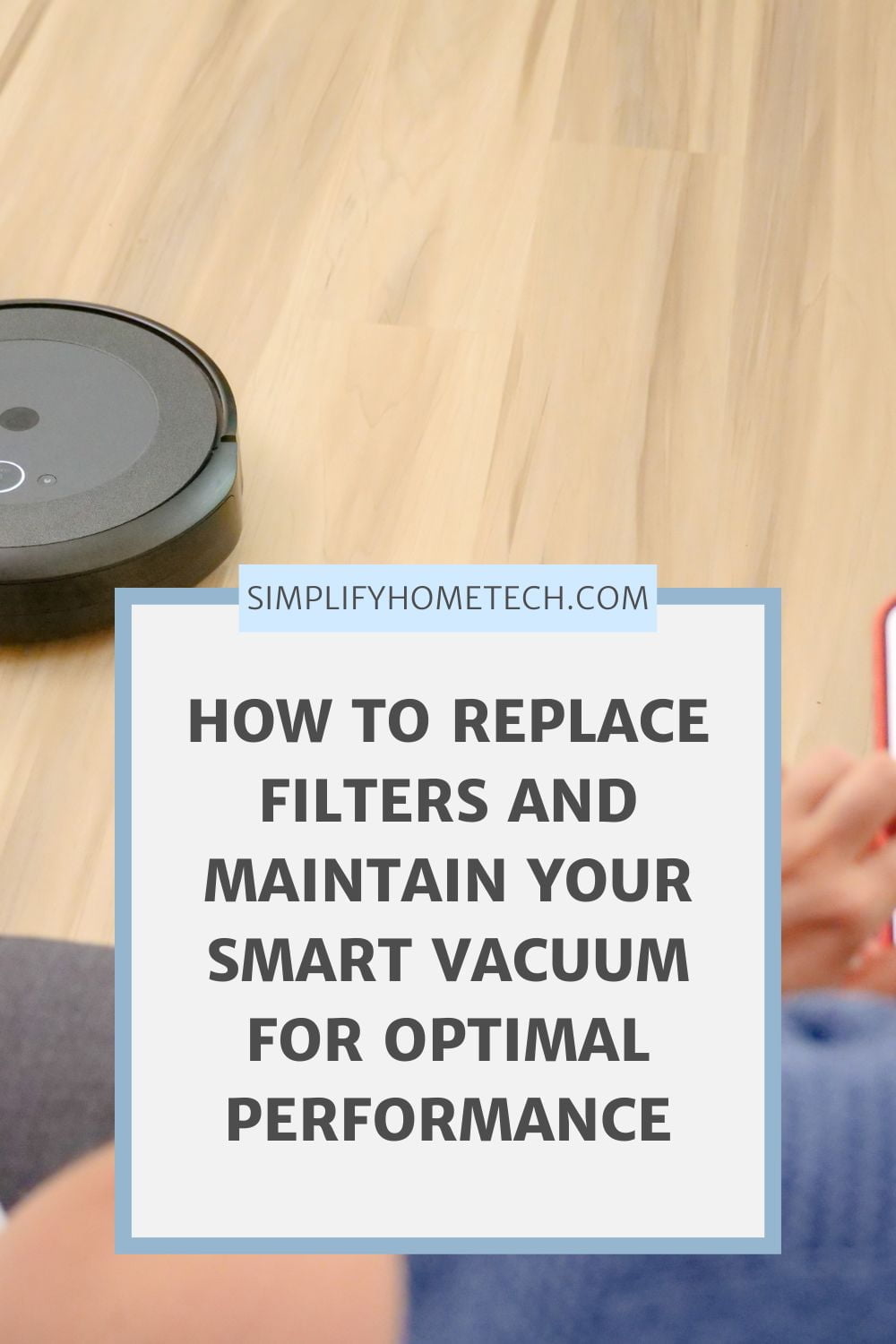Smart vacuums are a great way to keep your floors clean without lifting a finger. These devices can navigate around your home, avoid obstacles, and pick up dirt, dust, and debris with ease. Some models can even mop your floors and sanitize them with UV light.
But how do you keep your smart vacuum in good condition? One of the most important things that you should do is to replace the filters and maintain your smart vacuum regularly. This will ensure that your smart vacuum works properly and efficiently and that it lasts longer.
In this article, we’ll explain why replacing filters and maintaining your smart vacuum is essential, and how to do it correctly. We’ll also share some tips and tricks on how to make the most of your smart vacuum.
Why is Replacing Filters and Maintaining Your Smart Vacuum Essential?
Replacing filters and maintaining your smart vacuum is essential for several reasons, such as:
- Improving performance: The filters in your smart vacuum trap dust, dirt, allergens, and other particles that the device sucks up. Over time, these filters can get clogged or dirty, which can reduce the suction power and airflow of your smart vacuum. By replacing or cleaning the filters regularly, you can ensure that your smart vacuum performs at its best.
- Extending lifespan: The filters in your smart vacuum also protect the motor and other components from damage caused by dust and debris. If you don’t replace or clean the filters regularly, they can cause overheating, malfunctioning, or breakdown of your smart vacuum. By replacing or cleaning the filters regularly, you can extend the lifespan of your smart vacuum and avoid costly repairs or replacements.
- Enhancing hygiene: The filters in your smart vacuum also affect the air quality and hygiene of your home. If you don’t replace or clean the filters regularly, they can release dust, dirt, allergens, and other particles back into the air or onto the floor. This can worsen allergies, asthma, or other respiratory problems for you and your family. By replacing or cleaning the filters regularly, you can enhance the hygiene of your home and prevent health issues.
How to Replace Filters and Maintain Your Smart Vacuum Correctly?
The exact steps for replacing filters and maintaining your smart vacuum may vary depending on the model and brand of your device. However, the general steps are as follows:
Check the manual
Before you start replacing filters or maintaining your smart vacuum, you should check the manual that came with your device. The manual will tell you what type of filters your smart vacuum has, where they are located, how often they need to be replaced or cleaned, and how to do it correctly. You should also check the manual for any other maintenance tips or instructions for your specific model.
Unplug the device
Before you touch any part of your smart vacuum, you should unplug it from the power source. This will prevent any electric shock or damage to yourself or the device.
Empty the dustbin
Before you replace or clean the filters in your smart vacuum, you should empty the dustbin that collects the dirt and debris that the device sucks up. You should empty the dustbin before and after each use of your smart vacuum, or whenever it is full. To empty the dustbin, you should remove it from the device and dump out its contents into a trash bin. You should also rinse the dustbin with water if it is dirty or dusty.
Replace or clean the pre-motor filter
Depending on the model of your smart vacuum, you may have a pre-motor filter that protects the motor from dust and debris that the device sucks up. This filter may be washable or disposable depending on the model of your smart vacuum. If it is washable, you should rinse it with cold water until it runs clear every month or so. If it is disposable, you should replace it every 3 to 6 months or whenever it is dirty.
Replace or clean the post-motor filter
Depending on the model of your smart vacuum, you may have a post-motor filter that traps dust, dirt, allergens, and other particles that the device blows out. This filter may be washable or disposable depending on the model of your smart vacuum. If it is washable, you should rinse it with cold water until it runs clear every month or so. If it is disposable, you should replace it every 3 to 6 months or whenever it is dirty.
Replace or clean the HEPA filter
Depending on the model of your smart vacuum, you may have a HEPA filter that captures 99.97% of particles as small as 0.3 microns, such as dust mites, pollen, mold spores, and pet dander. This filter may be washable or disposable depending on the model of your smart vacuum. If it is washable, you should rinse it with cold water until it runs clear every month or so. If it is disposable, you should replace it every 6 to 12 months or whenever it is dirty.
Inspect and clean the roller brush
This is a rotating brush that agitates the dirt and debris on the floor and feeds them into the suction path of your smart vacuum. Over time, the roller brush may get tangled with hair, fibers, or other objects which may reduce its efficiency or cause damage to the device. To inspect and clean the roller brush, you should remove it from the device and cut off any hair or fibers that are wrapped around it. You should also wipe off any dust or dirt that is stuck on it.
Inspect and replace the belt
This is a rubber band that connects the roller brush to the motor of your smart vacuum. Over time, the belt may wear out, stretch, or break, which may affect the rotation of the roller brush or cause noise or smell from the device. To inspect and replace the belt, you should remove it from the device and check for any signs of damage or wear. You should also measure its length and compare it with a new belt to see if it has stretched. If the belt is damaged, worn, or stretched, you should replace it with a new one that matches your model.
Inspect and clean the hose
This is a flexible tube that connects the suction path of your smart vacuum to the dustbin. Over time, the hose may get clogged with dust, dirt, or debris that may reduce the suction power or airflow of your smart vacuum. To inspect and clean the hose, you should detach it from the device and look inside for any blockages. You should also use a long object such as a broom handle or a coat hanger to push out any clogs that are inside the hose.
Inspect and clean the sensors
These are devices that help your smart vacuum to navigate around your home and avoid obstacles. Over time, the sensors may get dirty or dusty, which may affect their accuracy or functionality. To inspect and clean the sensors, you should locate them on your smart vacuum and wipe them gently with a soft cloth or a cotton swab.
Store the device properly
After you finish replacing filters and maintaining your smart vacuum, you should store it properly to prevent any damage or deterioration. You should store your smart vacuum in a cool, dry place away from direct sunlight or heat sources. You should also keep it away from children or pets who may tamper with it or harm themselves.
FAQs about Replacing Filters and Maintaining Your Smart Vacuum
Here are some frequently asked questions about replacing filters and maintaining your smart vacuum:
Q. How often should I replace filters and maintain my smart vacuum?
A. The frequency of replacing filters and maintaining your smart vacuum depends on several factors, such as the model of your device, the type of filters it has, how often you use it, and how dirty your home is. Generally, you should follow the recommendations in the manual of your device or on the filters themselves. As a rule of thumb, you should replace or clean the filters every 3 to 12 months, depending on their type and condition. You should also inspect and clean other parts of your smart vacuum every month or so.
Q. How do I know if my filters need to be replaced or cleaned?
A. some signs indicate that your filters need to be replaced or cleaned, such as:
- Reduced suction power or airflow
- Increased noise or smell from the device
- Dusty or dirty exhaust air
- Visible dirt or debris on the filters
- Damage or wear on the filters
If you notice any of these signs, you should check your filters and replace or clean them as needed.
Q. Where can I buy replacement filters for my smart vacuum?
A. You can buy replacement filters for your smart vacuum from various sources, such as:
- The manufacturer’s website
- Online retailers such as Amazon
- Hardware stores or home centers
- Vacuum repair shops
You should make sure that you buy replacement filters that match your model and brand of smart vacuum.
Conclusion
Replacing filters and maintaining your smart vacuum is essential for improving its performance, extending its lifespan, and enhancing its hygiene. You should check the manual of your smart vacuum to find out what type of filters it has, where they are located, how often they need to be replaced or cleaned, and how to do it correctly. You should also inspect and clean other parts of your smart vacuum that may affect its efficiency or functionality, such as the roller brush, belt, hose, and sensors. By replacing filters and maintaining your smart vacuum regularly, you can enjoy a cleaner and smarter home with minimal effort.
If you’re looking for a smart vacuum that has easy-to-replace filters and low-maintenance parts, we recommend checking out the Eufy RoboVac G30 Edge. This smart vacuum features Smart Dynamic Navigation 2.0 Technology that allows it to create an efficient cleaning path for every room. It also has a powerful suction of 2000Pa, a large dustbin of 0.6L, and boundary strips to keep it away from certain areas. You can use the EufyHome app to control and monitor your smart vacuum’s cleaning process.
To learn more about the Eufy RoboVac G30 Edge and how it can help you replace filters and maintain your smart vacuum easily and effectively, visit eufylife.com today.
You might also like,
How to Optimize Cleaning Performance with Your Smart Vacuum’s Mapping Feature

